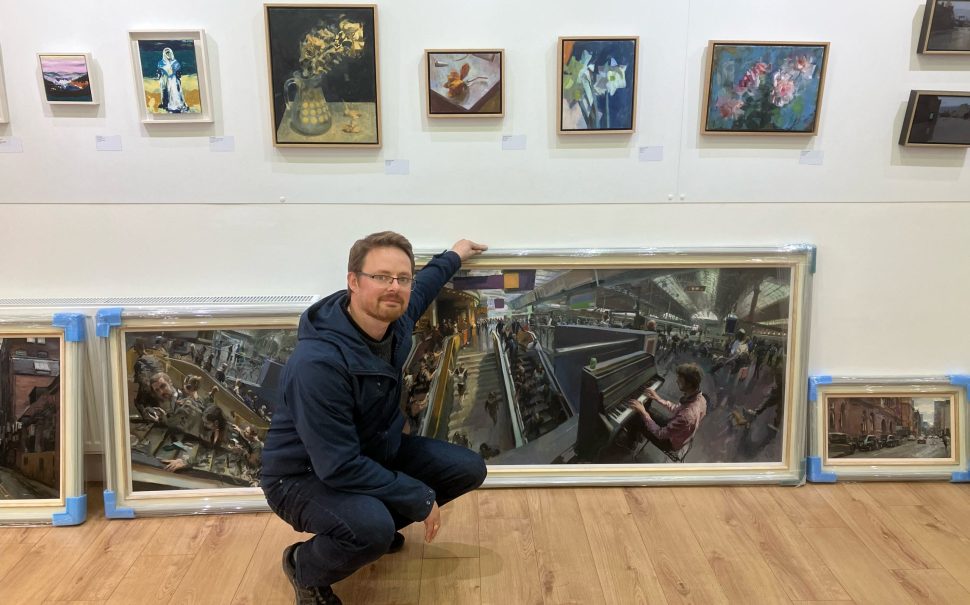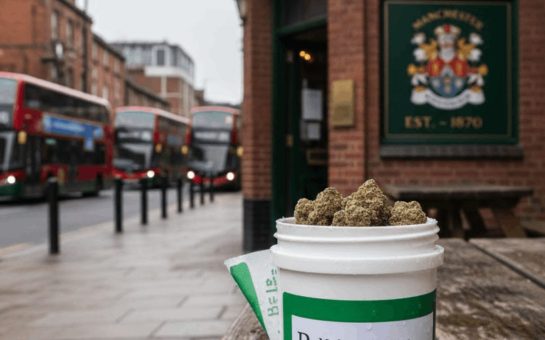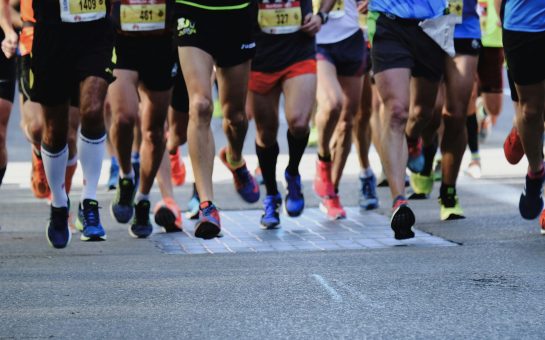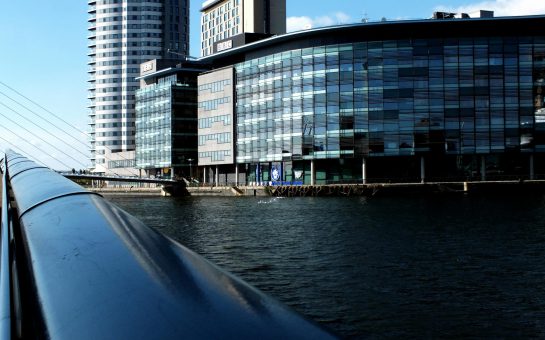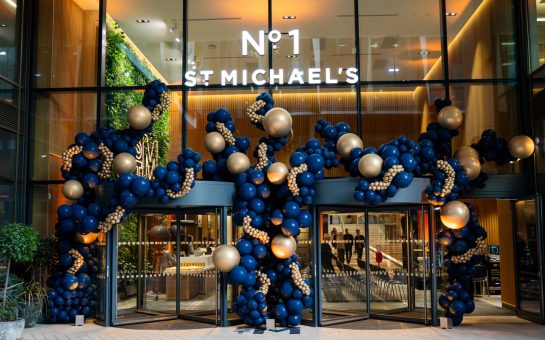For most people strolling along the many streets of Manchester, its escalators and alleyways are of no distinct significance.
Instead, they exist as mere cogs of a greater metropolitan machine – important as an element of the whole picture, and nothing more.
Rob Pointon, elected to the Royal Institute of Oil Painters in 2019, sees these otherwise unimportant aspects of daily life in a different light.
To the Cheshire-based artist, these typically hidden areas of existence are of the utmost integrity to our immediate world – something that should be represented in his work so members of the public can see the surreptitious colour and vibrancy of life.
“I’ve painted those escalators around twenty times now. I just love the constant movement of them.”
We are stood nattering away on the firm wooden floorboards of Contemporary Six Gallery, located within the construction-ravaged rat run that is Princess Street.
Between 2 and 18 November, the gallery will be hosting Pointon’s first exhibition in the city since 2020.
Its title, ‘Manchester’s Urban Tapestry: A Painter’s Perspective’, reveals quite a lot about the show’s contents – from back alleys to busy streets, depicted through the detailed eye of the beholder.
However, it does not satisfy my curiosity as to why these scenes merit an artistic depiction.
In turn, I have just asked Pointon what attracts him to the escalators of Manchester Piccadilly Station – a place which appears to a be a peculiar but key feature of his recent work.
The piece we are observing at the time portrays a sight most Mancunian commuters have witnessed during their travels. A man plays the piano, as a bustling crowd shifts determinedly towards their intended destination.
“With the piano being placed just above them, it’s a nice mix of having him in his own world playing music and then all these commuters spinning around in a sort of tornado.”
I see the simplicity of the scene. Pointon, somewhat naturally, sees it differently.
Still, I cannot get my head around why he has chosen Manchester Piccadilly Station – of all the beautiful spots within Manchester – as the source of his inspiration.
So, I ask again: what is so attractive about this scene, usually viewed by the people of Manchester as an inescapable Hades of public transport?
Pointon refreshes his answer by admitting the peculiarity of his ways – although there is, expectedly, a method to his madness.
“This is a strange one. Normally, the busier the better in these scenes. I’ll put myself in a very busy spot, such as a street and try and get as much movement and stimulus for my eye in the rectangle I’m painting, to make the work as engaging as possible.
“With this show, there are quite a few quieter back street scenes. I’ve started to like them and appreciate them. I try to capture all their qualities.”
As a ‘plein air’ painter – a term terrifyingly easy to mispronounce – Pointon has a particular interest in creating his artwork outdoors, away from the stifling confines of an indoor studio or stuffy bedroom.
This aspect of his art is something in which he clearly finds pride. The thrill of clasping his artistic eye on a moving picture is seemingly too good to miss.
As a result, the Staffordshire-born painter is willing to break an adage typically associated with artists. He chooses to tell me how a typical piece of his is constructed, subsequently revealing the magic within.
“All the work in this show is always finished on location – no studio work.
“I like that because it’s almost like each mark is a direct experience. You see something and you just strive to get it down, whether it’s a moving person or whatever.
“That way of working gets more energy – and hopefully more reality.”
An element of perhaps greater importance in the development of an artistic creation is what occupies the surface offered by the palette being used.
Such a matter can render some painters mere slaves to their material, as an individual’s one-time vision of beauty is twisted into a malignant monster of pure disappointment.
The use of oil paints within Pointon’s pieces is an undoubted essential to the way he operates before the canvas.
He tells me that nowadays it is impossible for him to even contemplate infecting his palette with a different concoction of pigments, solvents, resins, and additives.
The benefits of his current methods are simply too good to resist, too illustrious to refuse.
“I like using oils rather than acrylics or water colours because they seem to be much richer, and the colours achieve more effects to make them more convincing and almost real – you can convey a reality with them.
“The colours can be more vibrant and more luminous. Because they stay wet for longer, you can blend them and get some really interesting, subtle gradients and things like that.
“I rarely use anything other than oils now. Even for quick sketches, I’ll always use oil paints.”
Beginning his life as an artist under the direction of his similarly creative grandmother as a child in the post-modern world of the 1980s, Pointon’s career has jumped through many a hurdle to reach the position he today holds.
After studying Fine Art at Aberystwyth University and then completing ‘The Drawing Year’ at London’s prestigious Royal Drawing School in 2006, two decades were spent seeking success in the at times ruthless world of art.
Finally, official notoriety in these spheres was reached when Pointon was elected to be a member of the well-renown Royal Institute of Oil Painters in 2019.
This achievement was soon followed by further royal recognition, following a daring and spontaneous attempt of depicting the Household Cavalry sentries – who historically protect the Crown from any unwanted attacks.
“Before Covid-19, I saw the household cavalry sentries in the boxes on Whitehall, amazingly turned out, (in their) polished uniforms. I thought ‘what a good subject they’d be – they don’t move all day’.
“Doing that caused a bit of a stir. I didn’t know if I was going to get moved on!
“Luckily this officer came along and didn’t move me on. Instead, he took an interest in what I was doing and later introduced me to the museum director for the household cavalry museum.
“Next thing, I told them about the other residences I’d done and I became the regiment’s resident artist for a 12 month period, which was later extended to two years.”
A cacophony of accolades and official postings were soon to follow, as Pointon’s name became associated with some of the biggest and most grandiose events in living royal history.
“(The residency) was supposed to be just documenting how the regiment responded to Covid-19, but the next thing you know it was the Platinum Jubilee and then the Queen passed. I was sketching inside Westminster Hall during (Her Majesty’s) lying in state. Then I thought it was all finished.
“(After that) I got an email from an Irish guard major who said he had seen what I had done with the household cavalry. He offered for me to come back and do a residence with the household division.
“(Additionally) I was told I can have a front row seat for the coronation. I couldn’t really say no to that, you know?”
In this position, Pointon has also been able to add his personal flourish of colour to the most decorous duties of King Charles III and the royal household.
💂💂Trooping the Colour 2023💂💂
— Rob Pointon ROI (@Rob_Pointon) June 28, 2023
'The First Birthday Parade of the New Reign'
40"x48"
Fantastic vantage point to capture The Welsh Guard parade their colour in front of HRH King Charles III.#troopingthecolour @Householddiv @ArmyInLondon@BritishArmy #KingCharlesIII pic.twitter.com/1c9YYb9pQL
“I was in the Buckingham Palace gardens as the King presented different standards and colours to the RAF, Navy, and company grenadiers. It was an amazing ‘tri-service’ of handing out these new flags, ahead of the coronation.
“It’s just a really fortunate series of events, and it’s just like a golden thread that I’m pulling along.”
Asked whether he is proud of what he has attained in these royal postings, the artist portrays an image of humility and gratitude to my own observing eye.
“I’m really proud and I’m really proud that it came about not because of who I know, but just through working as a street artist in London.
“I was so fortunate to get into that space with the Queen’s coffin while the country was queuing past.
“It was such an honour. You feel the weight of responsibility to do a good job.”
Speaking to Mancunian Matters via email ahead of the upcoming exhibition, Alex Reuben – Contemporary Six Gallery’s owner – is unrestricted in his praise of an individual who seems to be a prodigy well in the making.
“Over the last couple of years, Pointon has strengthened his reputation as one of the most exciting and sought after artists in the UK.
“Within the northern art scene, I can say in all confidence that Rob is truly one of the greatest talents of his generation and I predict big things for him in the future.”
This talk is not merely an attempt by the gallery to cash in on the opportunity to attract hordes of guests through a brief chat to the media.
Examining the works already teased on social media and in-person ahead of the event, it is apparent to the naked eye that Pointon is the real deal.
He possesses a keen eye for details that too often go unnoticed by an ever-dynamic Manchester public, excessively concentrated on the path ahead and unable to offer due regard to what so effortlessly surrounds us each day.
But that, admittedly, is only my view of what I have learnt after catching a brief glimpse of the paintings to be displayed as early as next week.
So, with this self-awareness in mind, I question Pointon on what he hopes the audience will take away from the 30 paintings set to be shown at the upcoming exhibition.
“My aim is to just produce better and better painting through practice, developing techniques and honing them.
“I think, through all of that, the public are able to identify with the works just that bit more. I hope they recognise the atmosphere, or the feelings conveyed by them.
“I think that’s all you can hope for as an artist – that you make a statement people can relate to and identify with in some way or another, be that even in an unnerving kind of feeling. Especially in some of these alleyways perhaps, or maybe look again at the city.
“I like these back-alley scenes for a more honest, unpolished view of the city.”
He also sees such work as a way to pay homage to great artists of the north who have already passed through these streets, restaurants, and alleyways – albeit in his own fashion.
“Your Majors and Lowrys – there’s a whole lineage of painters who’ve painted the north and hopefully I can slide into that lineage somewhere and stand on the shoulders of these giants.
“It’s nice to see quite a few of us going out there and trying to capture the city, and our images are different than those of the past. They are very contemporary and very much in the moment – warts and all.”
As they say, beauty is in the eye of the beholder. It is quite evident that Pointon sees it in a way not many others do – including, almost especially, escalators.
Robert Pointon’s solo exhibition, titled ‘Manchester’s Urban Tapestry: A Painter’s Perspective’, will be held at Contemporary Six Gallery on Princess Street between 2 and 18 November. A digital viewing of the exhibition will be available on the gallery’s website at 17:30pm on Friday 27 October.
Featured image credit: Oliver Jervis
